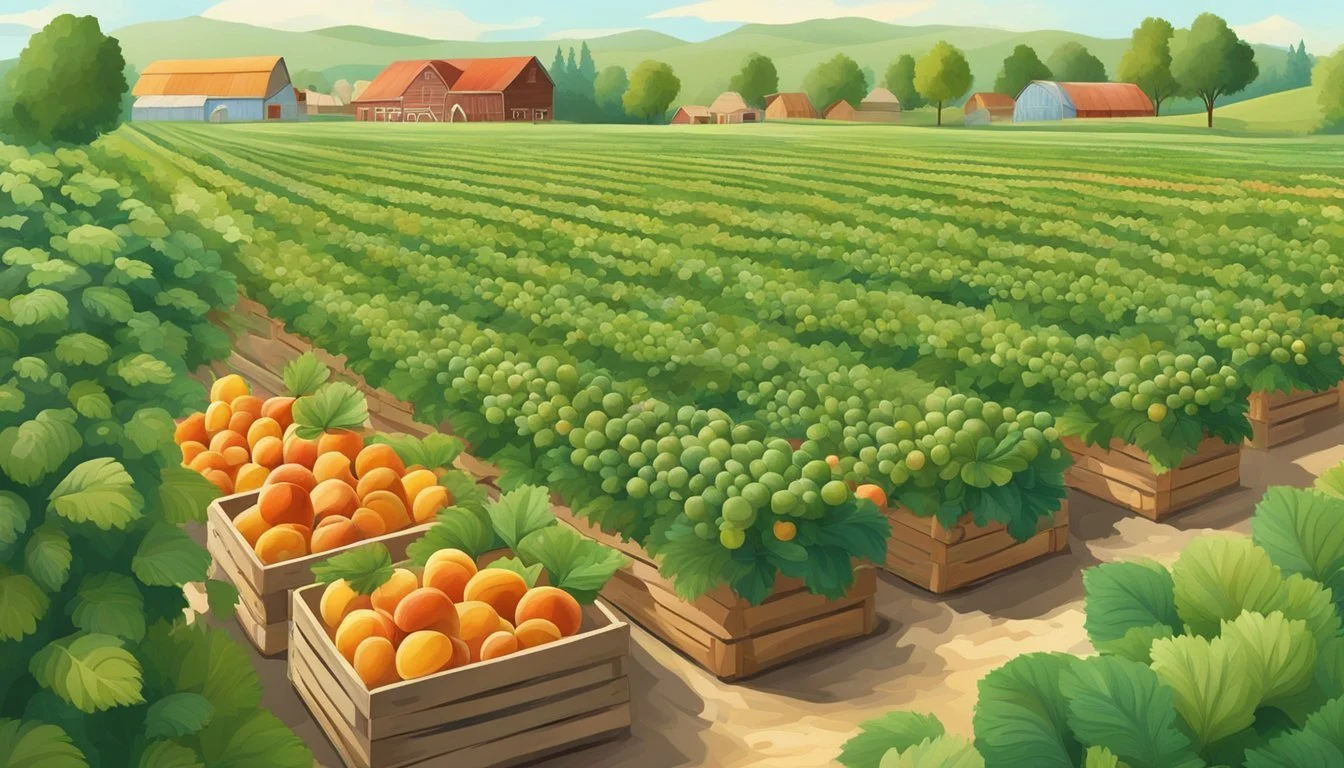Oregon Seasonal Fruit & Vegetables in May
Your Fresh Guide
This Article is Part of our Oregon Seasonal Fruit & Veg Calendar
As spring reaches its peak in May, Oregon's agricultural wealth begins to reveal itself in the form of fresh, vibrant produce. This period marks a transitional time in the state's farming calendar when the cool-weather crops of early spring make room for the onset of warmer season fare. The rich volcanic soil, coupled with the temperate climate of the region, allows a diverse range of fruits and vegetables to thrive.
In May, the fields and orchards of Oregon are typically abundant with the green hues of leafy vegetables and the bright colors of flowering fruit trees. The arrival of May signals the time for strawberries to start making their eagerly awaited appearance in the markets, offering a tantalizing taste of the bounty that follows. Concurrently, vegetables like asparagus (What wine goes well with asparagus?) and radishes reach their optimal flavor, as they benefit from the cooler nights and progressively warmer days.
Local farmers' markets and roadside stands become increasingly vibrant with a broadening array of products. As people eagerly anticipate the fullness of summer, Oregon's May produce provides a preview of the state's agricultural richness, with each region showcasing its specialties. The emphasis on seasonal eating not only supports local farmers but also ensures that consumers are getting the freshest and most flavorful produce available.
Overview of Oregon's Growing Seasons
Oregon’s diverse climate yields a multitude of growing seasons throughout the year. The state's landscape is partitioned into distinct regions, each with its own unique climate patterns impacting their respective growing seasons.
Spring in Oregon sees the softening of the soil as temperatures gradually rise. It's the beginning of the planting season for many early vegetables. Asparagus, for example, begins its season in April, while rhubarb is often ready to harvest by May.
During summer, the warmer weather significantly extends the growing season across the state. This period is ideal for a variety of fruits and vegetables. June marks the start for crops like blueberries and blackberries, with many other produce items such as tomatoes and corn reaching peak ripeness in the summer months.
Fall brings cooler temperatures and the harvest of late-season produce before the frost. Many root vegetables and leafy greens thrive well into November, with winter squash varieties commonly harvested during this time.
Winter challenges growers with colder temperatures and shorter days, yet hearty crops like kale and Brussels sprouts (how long do brussels sprouts last?) can endure the cold. In some regions, growers utilize greenhouses or hoop houses to extend the growing season of certain crops well into the winter months.
Season Typical Crops Spring Asparagus, Rhubarb Summer Blueberries, Tomatoes, Corn Fall Root vegetables, Winter squash Winter Kale, Brussels sprouts
Oregon's climates range from the wet coastal regions to the drier central and eastern areas, each influencing local growing seasons. The mild maritime climate along the coast supports an extended growing season, while the interior valleys deal with more variable temperature swings, limiting some crops to shorter growth periods. The state practices a vibrant agricultural rhythm, tuned in harmony with its varied weather and climate conditions.
Seasonal Fruit Highlights in May
Entering May, Oregon's markets begin to brim with fresh, locally-sourced fruits. Of particular note are two seasonal delights: strawberries and rhubarb, each offering vibrant flavors unique to this time of year.
Strawberries
Oregon strawberries in May are just beginning their season, which typically stretches from May through August. Known for their bright red color and sweet, juicy flavor, these berries are a favorite for both fresh eating and culinary uses. They become available in markets and for picking, heralding the start of berry season with their arrival.
Rhubarb
Rhubarb also makes its seasonal debut in May and continues through the summer. While technically a vegetable, it's often used as a fruit in culinary contexts, particularly in pies and desserts. Its tartness complements the sweetness of other fruits like strawberries, making it a popular ingredient for spring and early summer recipes. Fresh rhubarb can be identified by its crimson stalks and green leaves, which are not consumed.
Seasonal Vegetable Highlights in May
May in Oregon welcomes the peak season for a selection of fresh vegetables, with offerings such as artichokes (What wine goes well with artichokes?)and asparagus standing out due to their freshness and availability in local markets.
Artichokes
In Oregon, artichokes reach their peak during May, providing a fresh and flavorful option for seasonal eating. Grown primarily on the coast, these globes are known for their tender hearts and are a quintessential feature at farmers' markets this time of year. They are versatile in the kitchen, suitable for steaming, grilling, or even stuffing.
Asparagus
This spear-like vegetable is a harbinger of spring and is at its most tender and abundant in May. Oregon's asparagus can be distinguished by its freshness, often harvested when it's just right, making it a favorite for both raw and cooked dishes. Rich in nutrients, it lends itself well to a variety of culinary uses, from roasting to inclusion in vibrant spring salads.
Full List of May Fruits in Oregon
In May, Oregon's fruit season begins to bloom with a modest but delightful selection. The appetite for fresh, local produce is graciously met by a variety of fruits coming into season. Here is a curated list of fruits ripe for picking during this spring month:
Strawberries: One of the first berries to welcome the warmer days. Oregon strawberries are known for their vibrant red color and sweet, juicy flavor.
Rhubarb: Though commonly prepared as a fruit in culinary practices, rhubarb is technically a vegetable. Its tart stalks are often used in desserts, such as pies and jams.
Cherries: Towards the end of May, cherries start to make an appearance. The state's climate provides ideal conditions for growing these succulent, sweet, or tart delights.
Note: May is generally early for apples, which tend to ripen later in the year, but early varieties may start to become available depending on the region within Oregon and the seasonal conditions of that particular year.
The availability of these fruits can vary based on factors such as specific regional climates and annual weather conditions. Consumers are encouraged to check with local farms for the most accurate and timely information regarding fruit availability. Supporting local agriculture not only provides the freshest fruits but also contributes to the sustainability of Oregon's farming communities.
Full List of May Vegetables in Oregon
In Oregon, the month of May heralds the arrival of a wide variety of vegetables fresh for the picking. Local markets start to brim with produce that is both vibrant and packed with nutrients. Here is what consumers can expect to find:
Artichokes: These thistle-like vegetables flourish in May, offering their unique flavor and texture to a range of dishes.
Asparagus: A prized vegetable for its tender shoots, asparagus reaches its peak during this month.
Peas: May sees sweet peas become readily available, perfect for brightening up salads and sides.
Oregon's farmlands also deliver a bounty of Greens in May. Grocery aisles and farmers' markets showcase a variety of leafy vegetables, known for their health benefits:
Arugula (how long does arugula last?)
Spinach
As for Peppers, they begin to appear in May, though they usually reach their abundance later in the summer. Nonetheless, consumers may start to see the early varieties of these versatile vegetables.
This comprehensive list represents Oregon's lush agriculture during May, offering a snapshot of the vegetables at their prime in this season. Fresh produce enthusiasts have much to look forward to when shopping during this period.
Understanding Crop Availability
In May, Oregon's agricultural output is influenced by its temperate climate and spring weather conditions, which contribute to the variety and quality of its crops. The state's robust agricultural calendar indicates a shift as spring crops reach their peak availability, providing consumers with a wealth of fresh produce options.
Fruit Availability:
Oregon's climate, characterized by cold wet winters and warm dry summers, supports a diverse array of fruit crops. In May, consumers can expect:
Strawberries: With their prime season starting, they are a highlight of the spring months.
Rhubarb: Typically harvested in spring and available until June.
Vegetable Availability:
Oregon’s agriculture benefits from its rich soils and varied climate, which allow for the thriving of many vegetables:
Asparagus: This spring vegetable is often at its tender best.
Leafy Greens: Including spinach and varieties of lettuce.
Radishes: These root vegetables start becoming available.
Peas: Offer a burst of sweetness, often ready towards the end of the month.
Herbs:
Fresh herbs such as parsley and chives come into season, adding flavor and aroma to dishes.
The state's weather patterns, particularly in the Willamette Valley, which receives ample rain, provide ideal conditions for these crops to flourish. May marks a period when Oregon’s farmers markets and grocery selections become more vibrant with these seasonal offerings. As the month progresses, the transition from spring to summer crops begins, guided by the longer days and warmer temperatures ideal for the next wave of fruits and vegetables.
Cooking with May's Seasonal Produce
In Oregon, the spring month of May is a pivotal time for farmers and food enthusiasts alike, as it introduces a variety of fresh produce ripe for the kitchen. The use of seasonal vegetables and fruits not only ensures peak flavor but also supports local agriculture and sustainability.
Vegetables in season, such as asparagus, arugula, and spinach, offer a fresh crunch and vibrant green to dishes. One might consider them for recipes like refreshing salads or light, springtime soups. For instance, a simple yet delicious asparagus soup can be a showcase of May's harvest.
Seasonal fruits like strawberries begin to appear in May, adding a sweet and juicy element to the culinary landscape. They can be used in fruit salads, desserts, or even incorporated into savory dishes for a delightful contrast in flavors.
May's produce selection also invites a variety of salad recipes, where fresh greens can be paired with an assortment of dressings to create nutritious and flavorsome meals. Incorporating ingredients such as radishes and pea shoots can add depth and a peppery zing to a garden salad, marrying the crisp textures with the tender lettuces.
May Seasonal Produce Suggested Recipes Asparagus Grilled, Roasted, or Soup Arugula Salads, Sandwiches Spinach Salads, Sautés, Smoothies Strawberries Salads, Desserts, Jams
Chefs and home cooks should take advantage of the abundance of fresh produce available in May. By choosing local and seasonal items, they can create meals that are not only delicious but also environmentally conscious and supportive of regional farming communities.
Where to Find Fresh Produce
In Oregon, May is a month of blossoming variety in agriculture, and finding fresh produce is an adventure in exploring local bounty. Farmers' markets across the state become vibrant hubs of activity, showcasing the latest seasonal offerings. Cities like Portland, Eugene, and Salem host markets featuring an array of fresh fruits and vegetables from local growers.
Portland Farmers Market: A gastronomic gem where one can discover fresh strawberries, tender asparagus, and a kaleidoscope of leafy greens.
Salem Saturday Market: A community staple for sourcing locally-grown rhubarb and a rich variety of herbs.
For those favoring a more hands-on experience, Oregon's farms offer u-pick opportunities. These farms provide not only fresh produce but also a connection to the source of one's food.
Local U-Pick Farms:
Strawberries: Invites visitors to gather their own baskets of sun-ripened berries.
Rhubarb: Offers the chance to select the freshest stems for springtime pies.
Agriculture Co-ops:
In addition, agriculture co-ops throughout Oregon serve as gateways to sustainable and organic produce, often directly supplied by the farming community.
To ensure the most flavorful and nutritious selections, it's recommended to inquire about the origins of produce and to favor seasonal offerings. Guided by a respect for Oregon's rich agricultural landscape, one can readily find produce that is both fresh and reflective of the local terroir.
Benefits of Eating Seasonally
Eating seasonally refers to the practice of consuming fruits and vegetables that are harvested at the time one intends to eat them. This mode of consumption aligns with nature's production cycle, providing several advantages.
Freshness and Nutritional Value: Seasonal produce is often synonymous with freshness. Fruits and vegetables picked during their peak season contain optimal levels of vitamins and minerals. For example, leafy greens harvested in spring are known for their high nutrient content.
Adjusting to the Body’s Needs: The body's nutritional requirements tend to vary with the seasons. In colder months, one might benefit from the higher vitamin C content in citrus fruits to bolster the immune system, while in warmer months, the high water content in summer fruits like strawberries can aid in hydration.
Support for Local Farmers and the Economy: When consumers choose seasonal items, they are often purchasing produce that has been grown locally. This not only lessens the environmental impact of transportation but also supports local agriculture and economy.
Season Suggested Seasonal Produce Spring Asparagus, Radishes Summer Berries, Tomatoes Fall Apples, Pumpkins Winter Squashes, Kale
Environmental Impact: Non-seasonal produce requires more resources for growth and transport, leading to a larger carbon footprint. In contrast, seasonal produce often has a lower environmental impact due to reduced requirements in these areas.
In summary, integrating seasonal fruits and vegetables into one's diet provides numerous health benefits, supports local economies, and is kinder to the environment.











